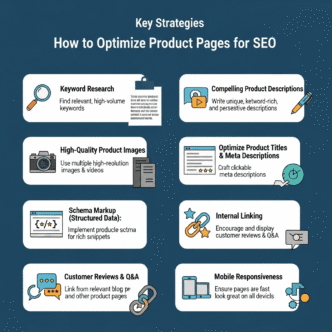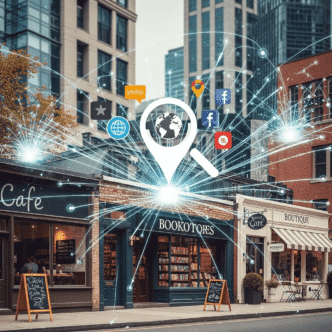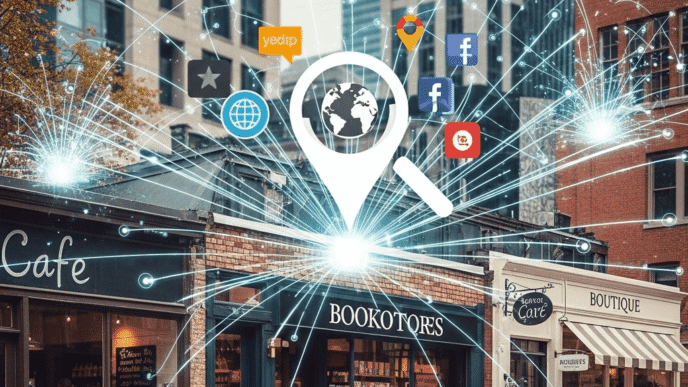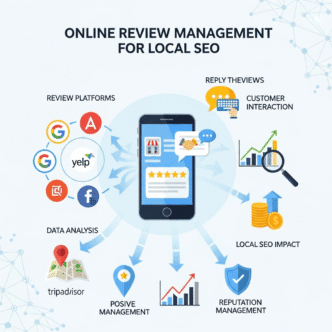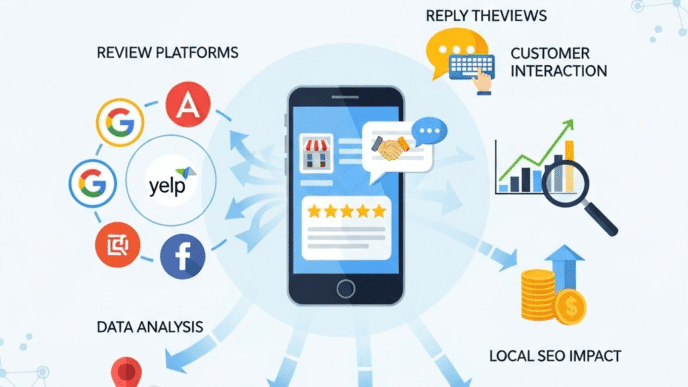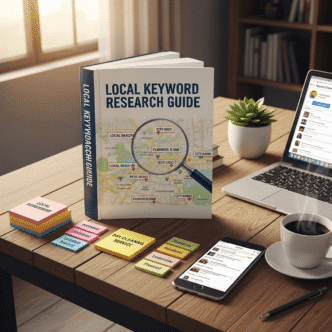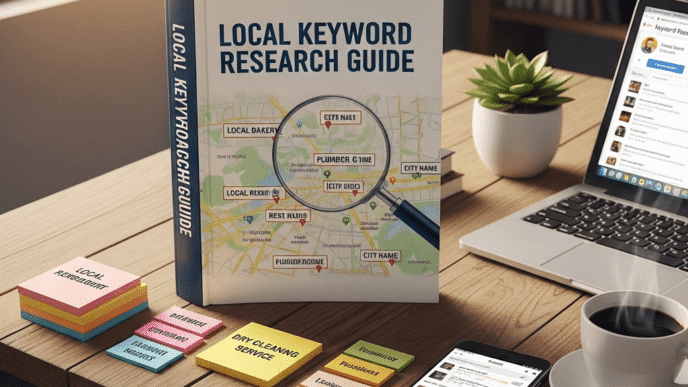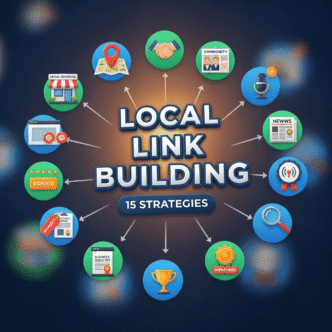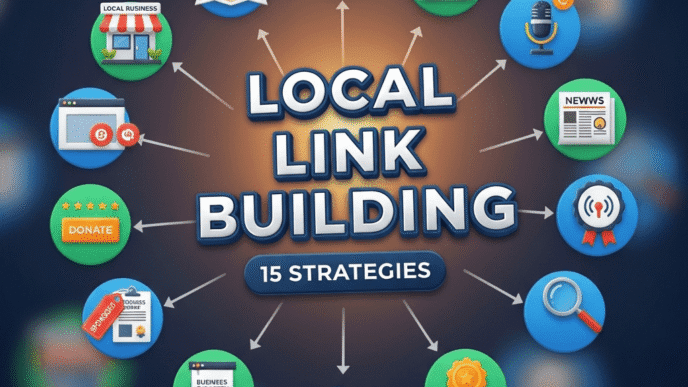Ever searched for “pizza near me” at 9 PM on a Friday night and found yourself scrolling past dozens of restaurants before finding one that’s actually open and close by?
That’s the power of local SEO at work—or not working, depending on which side of that search result you’re on.
Here’s the brutal truth: 46% of all Google searches have local intent, and if your business isn’t showing up in those local search results, you’re basically invisible to potential customers who are ready to buy right now. We’re talking about people with their wallets open, standing in your neighborhood, looking for exactly what you offer.
In this local SEO guide, I’m going to show you exactly how to dominate local search in 2025, from optimizing your Google Business Profile to building citations that actually move the needle. Whether you’re a dental practice, a plumbing company, or a boutique coffee shop, this guide will help you show up when it matters most—when customers are searching in your area.
Let’s turn those “near me” searches into foot traffic and phone calls.
Table of Contents
ToggleWhat Is Local SEO and Why Should You Care?
Think of local search optimization as your digital storefront window. Just like a physical window display attracts passersby, local SEO ensures your business appears when nearby customers search for your services.
Local SEO is the practice of optimizing your online presence to attract more business from relevant local searches on Google and other search engines. It’s different from traditional SEO because it focuses on geographic-specific queries and aims to get your business visible in the local pack, Google Maps, and organic results.
Why Local SEO Matters More Than Ever in 2025
The numbers don’t lie. According to recent data, 76% of people who search for something nearby on their smartphone visit a related business within 24 hours, and 28% of those searches result in a purchase.
Here’s what’s changed in 2025:
Mobile search has completely taken over. Voice search queries like “find a dentist near me” and “best Mexican restaurant nearby” are skyrocketing. Google’s local algorithm has become more sophisticated, rewarding businesses that provide accurate information and genuine customer value.
The competition is fiercer than ever. Your competitors are investing in local search marketing, and if you’re not keeping up, you’re falling behind.
“Local SEO is no longer optional for small businesses—it’s the difference between being found by customers ready to buy and being completely invisible to your local market.” — Danny Sullivan, Google Search Liaison
Real-World Example:
Sarah owns a boutique coffee shop in Portland’s Pearl District. When she opened in 2023, she relied solely on foot traffic and word-of-mouth. By March 2024, she implemented a basic local SEO strategy: claimed her Google Business Profile, added 30 photos, and asked customers for reviews. Within 60 days, her “directions requested” on Google Maps increased by 340%, and she tracked a 28% increase in new customers who mentioned “finding her on Google.”
Pro Tip: Local SEO isn’t just for brick-and-mortar stores anymore. Service-area businesses like plumbers, electricians, and consultants who travel to clients can dominate local search too by optimizing for service areas instead of a single address.
How Does Google Decide Which Local Businesses to Show?
Google uses three primary factors to determine local search rankings, and understanding these is crucial for your local SEO strategies.
Relevance measures how well your business matches what someone is searching for. If someone searches for “emergency plumber,” Google wants to show actual plumbing businesses, not general contractors who occasionally fix pipes.
Distance considers how far your business is from the searcher’s location. This is why someone in downtown Chicago searching for “coffee shop” sees different results than someone in the suburbs—even if they use the exact same search term.
Prominence evaluates how well-known and authoritative your business is. Google looks at your reviews, citations, backlinks, and overall online presence to gauge your business’s credibility and popularity.
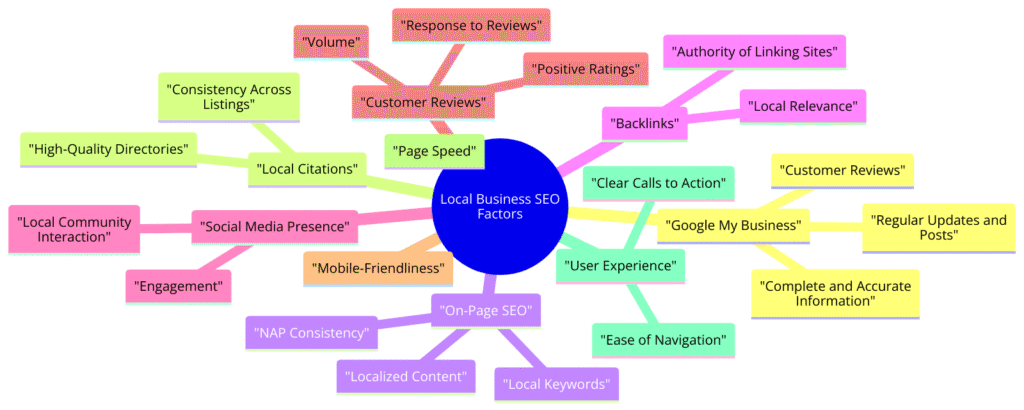
The Local Search Ranking Factors That Actually Matter
According to Whitespark’s 2025 Local Search Ranking Factors study, here are the elements that carry the most weight:
For Local Pack Rankings (the map results):
- Google Business Profile signals: 36%
- Review signals: 16%
- On-page signals: 14%
- Link signals: 13%
- Citation signals: 11%
- Behavioral signals: 10%
For Organic Local Rankings (below the map):
- On-page signals: 33%
- Link signals: 29%
- Google Business Profile signals: 15%
- Review signals: 8%
- Behavioral signals: 8%
- Citation signals: 7%
This data tells us exactly where to focus our efforts—and your Google Business Profile optimization should be priority number one.
“The businesses that win in local search aren’t necessarily the biggest or oldest—they’re the ones that make it easiest for Google to understand what they do, where they are, and why customers love them.” — Phil Rozek, Local Visibility System
What Is Google Business Profile and How Do You Optimize It?
Your Google Business Profile (formerly Google My Business) is the single most important element of your local SEO strategy. It’s the information box that appears when someone searches for your business or finds you on Google Maps.
Think of it as your business’s resume that Google shows to potential customers. If it’s incomplete, outdated, or poorly optimized, you’re shooting yourself in the foot before the race even starts.
How to Claim and Set Up Your Google Business Profile
Step 1: Claim Your Listing
Go to business.google.com and search for your business. If it exists, claim it. If not, create a new listing. Google will send you a verification postcard to your business address—this usually takes 5-10 days.
Step 2: Complete Every Single Field
I mean every field. Business name, address, phone number, website, hours, categories, attributes, services, products, photos, business description—all of it. Google rewards complete profiles with better visibility.
Step 3: Choose the Right Categories
Your primary category is crucial. For a pizzeria, “Pizza Restaurant” is better than just “Restaurant.” You can add up to 10 categories total, but your primary category carries the most weight.
Real-World Example:
Marcus runs a family law practice in Austin, Texas. Initially, he selected “Lawyer” as his primary category—a mistake that buried him under general attorneys. After researching what potential clients actually searched for, he changed his primary category to “Family Law Attorney” and added secondary categories like “Divorce Lawyer” and “Child Custody Lawyer.” Within 45 days, his visibility in local pack results for specific family law searches increased by 220%, and consultation bookings doubled.
Pro Tip: Don’t choose categories based on what you want to rank for—choose them based on what your business actually is. Google’s algorithm is smart enough to detect category manipulation, and it will hurt your rankings.
What Should You Include in Your Business Description?
Your business description is your chance to tell Google and potential customers what makes you special. You have 750 characters to work with, so make them count.
Here’s what works:
Start with your primary service and location in the first sentence. “Joe’s Plumbing provides 24/7 emergency plumbing services to Chicago and surrounding suburbs.”
Include your main services naturally. Don’t keyword stuff, but do mention what you actually do. “We specialize in drain cleaning, water heater repair, pipe replacement, and bathroom renovations.”
Highlight what makes you different. “Family-owned since 1985, we’re known for showing up on time and explaining everything in plain English before we start work.”
End with a call to action. “Call us today for a free estimate or same-day emergency service.”
What not to do: Don’t stuff keywords like “best plumber Chicago plumbing services emergency plumber near me.” Google sees right through this and it makes you look desperate to actual humans reading it.
How Many Photos Should You Upload?
Businesses with photos receive 42% more requests for directions and 35% more click-throughs to their websites than businesses without photos.
Upload at least:
- 3 exterior photos showing your building and signage
- 5 interior photos if you have a location customers visit
- 10 photos of your products or completed work
- 5 photos of your team
- A professional cover photo and logo
Update your photos monthly. Google favors fresh content, and new photos signal that your business is active and current.
Real-World Example:
Jennifer owns a yoga studio in Denver. She initially uploaded 5 generic stock photos of yoga poses. After hiring a local photographer to capture real classes with actual students (with permission), authentic studio shots, and behind-the-scenes team photos, she uploaded 40 original images over two months. Her Google Business Profile views increased 156%, and most importantly, the quality of new student inquiries improved because prospects could see the actual studio environment and community vibe before visiting.
What Are NAP Citations and Why Do They Matter?
NAP stands for Name, Address, Phone Number—the three pieces of information that identify your business across the internet. NAP consistency is one of the foundational elements of local SEO.
Think of citations as digital breadcrumbs that help Google verify your business exists and confirm its location. The more consistent these breadcrumbs are across the web, the more confident Google feels about showing your business in local search results.
Where Should Your Business Be Listed?
There are hundreds of citation sources, but start with these high-impact directories:
Essential Citations (Do These First):
- Google Business Profile
- Bing Places for Business
- Apple Maps (via Apple Business Connect)
- Facebook Business Page
- Yelp for Business
- Yellow Pages (yp.com)
- Better Business Bureau
- Local Chamber of Commerce
Industry-Specific Citations:
- Restaurants: TripAdvisor, OpenTable, Zomato, Yelp
- Healthcare: Healthgrades, Vitals, WebMD, Zocdoc
- Legal: Avvo, Justia, FindLaw, Lawyers.com
- Home Services: HomeAdvisor, Angie’s List, Thumbtack, Porch
Local Citations:
- Local news websites
- City business directories
- Local blogs and community websites
- Regional business associations
How Do You Ensure NAP Consistency?
This is where most businesses mess up. Your business name, address, and phone number must be identical across every single listing. Not similar. Identical.
Common consistency mistakes:
Inconsistent Business Names:
- “Joe’s Plumbing”
- “Joe’s Plumbing LLC”
- “Joe’s Plumbing Services”
- “Joes Plumbing” (missing apostrophe)
Pick one format and use it everywhere.
Inconsistent Addresses:
- “123 Main St”
- “123 Main Street”
- “123 Main St, Suite A”
- “123 Main Street, Ste A”
Choose one abbreviation style and stick with it.
Inconsistent Phone Numbers:
- (555) 123-4567
- 555-123-4567
- 5551234567
Use the same format everywhere.
“NAP consistency is like building trust with Google—every inconsistency is like telling Google a slightly different story about who you are. Eventually, Google stops believing any version of your story.” — Darren Shaw, Founder of Whitespark
Pro Tip: Use a spreadsheet to track every citation you create. Include the website, URL of your listing, username, password, and the exact NAP format you used. This makes updates infinitely easier when you move locations or change phone numbers.
How Do You Find and Fix Citation Errors?
Inconsistent citations confuse Google and dilute your local SEO power. Here’s how to find and fix them.
Manual Citation Audit:
Google your business name in quotes: “Your Business Name” + your city. Look through the first 10 pages of results and document every listing you find. Check each one for accuracy.
Use Citation Tracking Tools:
- Moz Local: Scans major directories and shows inconsistencies
- BrightLocal: Comprehensive citation tracking and monitoring
- Whitespark: Citation building and tracking for local SEO
- Yext: Automated citation management (expensive but effective)
Common Citation Errors to Fix:
- Old addresses from previous locations
- Disconnected phone numbers
- Outdated business hours
- Wrong website URLs
- Duplicate listings for the same business
- Listings for businesses that no longer exist
How to Fix Them:
Claim the listing if possible and update it directly. If you can’t claim it, contact the website’s support team with documentation proving you own the business. For stubborn listings on obscure directories, use Google’s feedback form to report incorrect information.
Real-World Example:
Tom’s Auto Repair in Seattle had moved locations three years prior but never updated their online citations. They were losing customers who showed up at the old address (now a vacant lot) and left angry reviews. After conducting a citation audit, they discovered 47 listings with the old address. They spent two weeks systematically updating each one. Within 90 days, their misdirected traffic dropped to zero, negative reviews stopped, and their local pack rankings improved as Google gained confidence in their current location.
What Keywords Should You Target for Local SEO?
Local keyword research is different from traditional keyword research because you’re competing in a defined geographic area, not globally.
The goal is to identify search terms that indicate commercial intent and include geographic modifiers that match your service area.
What Are the Different Types of Local Keywords?
Explicit Local Keywords include a location in the search term:
- “plumber in Chicago”
- “Chicago plumber”
- “plumbing services Chicago IL”
Implicit Local Keywords don’t include a location but trigger local results:
- “plumber near me”
- “emergency plumber”
- “24 hour plumbing service”
Google knows the searcher wants local results based on their location and the nature of the query.
Service + Location Keywords:
- “drain cleaning Chicago”
- “water heater repair Lincoln Park”
- “emergency plumber Gold Coast”
Neighborhood-Specific Keywords:
- “plumber in Lincoln Park”
- “Gold Coast plumbing services”
- “Wicker Park emergency plumber”
How Do You Find Local Keywords with Search Volume?
Use Google’s Autocomplete:
Start typing your service plus your city into Google and see what autocomplete suggests. These are real searches people are making.
Check Google’s “People Also Ask” and “Related Searches”:
These sections show you related queries that real people search for. Screenshot these and add them to your keyword list.
Use Keyword Research Tools:
- Google Keyword Planner: Free, shows search volume for specific locations
- Ahrefs: Filter keywords by location, see local difficulty scores
- SEMrush: Local keyword magic tool with city-specific data
- BrightLocal: Local search rank checker and keyword tool
See what keywords your local competitors rank for using Ahrefs or SEMrush. If they’re ranking for it, you can too.
Real-World Example:
Amanda owns a dog grooming salon in Nashville. She initially targeted broad keywords like “dog grooming Nashville” and struggled to rank. After using Google’s autocomplete feature, she discovered people were searching for specific services: “mobile dog grooming Nashville,” “cat grooming Nashville,” “dog teeth cleaning Nashville,” and neighborhood-specific terms like “dog grooming Green Hills” and “pet grooming Brentwood TN.” She created dedicated service and location pages for these long-tail keywords and started ranking within 60 days, increasing organic bookings by 180%.
What’s a Good Local Keyword Strategy?
Target a mix of head terms, mid-tail keywords, and long-tail phrases.
Head Terms (high competition, high volume):
- “plumber Chicago”
- “Chicago plumbing”
Mid-Tail Keywords (medium competition, decent volume):
- “emergency plumber Chicago”
- “Chicago drain cleaning services”
Long-Tail Keywords (low competition, lower volume but higher intent):
- “24 hour emergency plumber Lincoln Park”
- “same day water heater repair Chicago”
Pro Tip: Long-tail keywords might have lower search volume, but they often have much higher conversion rates because they indicate specific intent. Someone searching “emergency plumber near me open now” is ready to hire someone immediately.
How Do You Optimize Your Website for Local Search?
Your website is your digital headquarters for local SEO. While your Google Business Profile gets you into the local pack, your website helps you rank in the organic results below the map.
What On-Page Elements Matter Most for Local SEO?
Title Tags:
Include your primary keyword and location in every important page’s title tag. Keep it under 60 characters.
Good: “Emergency Plumber Chicago | 24/7 Service | Joe’s Plumbing” Bad: “Home | Joe’s Plumbing”
Meta Descriptions:
Include your location and a call to action. This doesn’t directly impact rankings, but it affects click-through rates.
Good: “Need a plumber in Chicago fast? Joe’s Plumbing offers 24/7 emergency service, upfront pricing, and same-day repairs. Call now: (555) 123-4567”
H1 Headers:
Your H1 should include your primary keyword and location.
Good: “Chicago’s Most Reliable Emergency Plumber” Bad: “Welcome to Our Website”
H2 and H3 Subheadings:
Use these to organize content and include secondary keywords naturally.
“What Our Chicago Plumbing Services Include” “Why Choose Our Lincoln Park Plumbing Team?”
Should You Create Location Pages?
If you serve multiple cities or neighborhoods, absolutely create dedicated location pages. These are essential for multi-location SEO strategies.
What to Include on Each Location Page:
Unique content about that specific location:
Don’t just copy and paste the same content with different city names. Google will penalize you for duplicate content. Write unique descriptions of how you serve each area.
Embedded Google Map:
Embed a map showing your business location or service area for that city.
Local landmarks and neighborhoods:
Mention nearby landmarks, neighborhoods you serve, and local references that establish relevance.
Location-specific testimonials:
Feature reviews from customers in that area.
Unique photos:
Show your team working in that location or photos of completed projects in that area.
NAP information:
Include your business name, address, and phone number (if you have multiple locations, list the relevant one).
Schema markup:
Add LocalBusiness schema to each location page.
Real-World Example:
Green Thumb Landscaping serves five suburbs outside of Boston. Initially, they had one generic “Service Areas” page listing all five towns. After creating individual location pages for each suburb with unique content—mentioning local regulations about lawn care, specific soil conditions in each area, photos of completed projects in each town, and testimonials from customers in each location—their organic traffic from those suburbs increased by 215% within four months. They now rank in the top 3 local pack results for “landscaping” searches in all five towns.
What Is Location-Based Content and How Do You Create It?
Location-based content establishes your business as part of the local community and helps you rank for neighborhood-specific searches.
Ideas for Local Content:
- “Top 10 Things to Do in [Neighborhood] This Summer”
- “The Ultimate Guide to [City] Restaurants”
- “How to Prepare Your [City] Home for Winter”
- “Local Spotlight: Supporting Small Businesses in [Neighborhood]”
- “[City] Event Calendar: What’s Happening This Month”
Pro Tip: Partner with other local businesses to create content. Interview a local restaurant owner, spotlight a neighborhood shop, or co-create a guide to your area. This builds relationships, earns backlinks, and establishes you as a community member, not just a business.
How Do You Rank Higher on Google Maps?
Google Maps ranking factors overlap with general local SEO, but there are specific strategies that work especially well for map pack visibility.
What’s the Difference Between Map Pack and Organic Rankings?
The local pack (or map pack) is the section showing three businesses with a map at the top of search results. These get the most visibility and clicks.
Organic local results appear below the map pack. These are traditional search results but filtered for local intent.
Most businesses obsess over map pack rankings because they get 44% of clicks on local searches, while the first organic result gets only 8.5%.
What Makes Google Show Your Business in the Map Pack?
Proximity is huge. The closer you are to the searcher, the better your chances of appearing. You can’t change your physical location, but you can optimize for your actual location rather than trying to fake one.
Relevance means your business must match the search query. Your category selection, keywords in your business description, and the services you list all contribute to relevance.
Prominence includes review quantity and quality, citation consistency, backlinks to your website, and social signals.
How Do You Optimize for Google Maps Specifically?
Complete every section of your Google Business Profile:
Google rewards profiles that provide comprehensive information. Fill out services, products, attributes, Q&A, and posts.
Get more reviews:
Businesses with 5+ reviews see a significant boost in map pack visibility. More on reviews in the next section.
Respond to all reviews:
Review responses show Google and customers that you’re actively engaged with your business profile.
Post regularly:
Google Posts keep your profile fresh and show activity. Post weekly updates, special offers, events, or news.
Add booking links:
If you offer appointments, add a booking button to your profile. Google favors profiles that make it easy for customers to take action.
Upload fresh photos:
Add new photos every week. Photos of recent work, new products, or happy customers signal activity.
Use Google Q&A:
Answer questions people ask on your profile. Better yet, proactively add questions and answers that address common customer concerns.
“The Google Business Profile is like a living, breathing organism. Feed it regularly with posts, photos, and engagement, and it grows stronger. Neglect it, and it withers and becomes invisible.” — Mike Blumenthal, Local Search Expert
Pro Tip: If you have a physical location customers visit, having your business name visible in Google Street View significantly helps map pack rankings. Make sure your signage is clear and visible from the street.
How Do Online Reviews Impact Local SEO?
Reviews are the lifeblood of local SEO. They influence rankings, build trust, and directly impact conversion rates.
According to BrightLocal’s 2025 Consumer Review Survey, 98% of consumers read online reviews for local businesses, and 76% trust online reviews as much as personal recommendations from friends and family.
What Review Signals Does Google Care About?
Review quantity: More reviews signal popularity and activity. Businesses with 50+ reviews typically rank higher than those with 5 reviews, assuming other factors are equal.
Review velocity: Getting a steady stream of new reviews shows your business is active. A burst of 30 reviews in one week looks suspicious, but 2-4 reviews per week looks natural and healthy.
Review rating: Obviously, higher ratings are better. The difference between 4.2 stars and 4.8 stars can be significant in both rankings and click-through rates.
Review diversity: Reviews across multiple platforms (Google, Yelp, Facebook, industry-specific sites) carry more weight than reviews on just one platform.
Review recency: Recent reviews matter more than old ones. A business with 100 reviews but nothing newer than two years ago looks inactive.
Review responses: Responding to reviews (both positive and negative) shows engagement and can improve your rankings.
How Do You Get More Reviews Without Breaking Google’s Rules?
You can ask for reviews, but you cannot offer incentives, selectively ask only happy customers, or write fake reviews. Google will penalize you for any of these.
Legitimate Ways to Get More Reviews:
Ask at the right time:
Request a review right after a positive experience. For restaurants, that’s immediately after the meal. For service businesses, that’s right after you complete the job and the customer expresses satisfaction.
Make it easy:
Send a direct link to your Google review page. Don’t make customers hunt for it. Use a URL shortener for a clean link: g.page/yourbusiness/review
Ask in person:
“If you’re happy with the work we did today, would you mind leaving us a quick review on Google? It really helps our small business.”
Follow up via email:
Send a thank-you email after the service and include a review request with a direct link.
Use SMS:
Text messages have a 98% open rate. A simple “Thanks for choosing us! We’d love your feedback: [review link]” works well.
Add it to your receipts:
Print a QR code on receipts that links to your review page.
Train your team:
Everyone who interacts with customers should know how to ask for reviews professionally.
Real-World Example:
Dr. Lisa Chen runs a dental practice in San Francisco. She had only 12 Google reviews despite serving hundreds of patients annually. She implemented a simple system: after successful cleanings or procedures, the front desk staff would say, “Dr. Chen would love your feedback on Google if you have a moment—it really helps other patients find us.” They included a business card with a QR code linking directly to their review page. Within six months, they went from 12 reviews to 187 reviews with an average of 4.9 stars. Their local pack visibility increased dramatically, and new patient inquiries doubled.
How Should You Respond to Negative Reviews?
Negative reviews happen to everyone. How you respond is what matters.
Respond quickly:
Address negative reviews within 24-48 hours. This shows you care and prevents the negative impression from festering.
Stay professional:
Never get defensive, argue, or attack the reviewer. Even if they’re wrong, your response is public and future customers are watching.
Acknowledge their experience:
Start with empathy. “I’m sorry you had this experience” or “Thank you for bringing this to our attention.”
Take it offline:
Provide a phone number or email and invite them to discuss it privately. “Please call me directly at (555) 123-4567 so I can make this right.”
Show improvement:
Explain what you’re doing to prevent similar issues. “We’ve retrained our team on this process to ensure it doesn’t happen again.”
“A complaint is a gift. It’s an opportunity to fix a problem you didn’t know you had, turn an unhappy customer into a loyal advocate, and show the world how you handle adversity with grace.” — Jay Baer, Customer Experience Expert
Pro Tip: A well-handled negative review can actually improve your reputation. 45% of consumers say they’re more likely to visit a business that responds professionally to negative reviews.
What Are the Best Local Link Building Strategies?
Local link building helps you rank in organic local results and builds authority that supports your map pack rankings.
The goal is to earn backlinks from other websites in your geographic area or industry that tell Google your business is legitimate and well-connected in the community.
What Types of Local Links Should You Build?
Local news coverage:
Get featured in local news sites, newspapers, and community blogs. These are high-authority, relevant links.
Local sponsorships:
Sponsor little league teams, charity events, school fundraisers, or community organizations. You’ll often get a link from their website.
Chamber of Commerce:
Join your local Chamber of Commerce. Most provide member directory listings with links.
Local business associations:
Industry-specific associations often have member directories.
Local education institutions:
Offer scholarships, sponsor programs, or provide internships. Schools and universities often link to sponsors and partners.
Community events:
Host or sponsor local events and get listed on event calendars and community websites.
Local bloggers and influencers:
Build relationships with local content creators and offer them something valuable in exchange for coverage.
How Do You Earn Links from Local News Sites?
Create newsworthy stories:
New locations, milestone anniversaries, unique services, community contributions, or interesting customer stories can all be newsworthy.
Pitch local journalists:
Build relationships with reporters who cover local business. Offer yourself as an expert source for industry-related stories.
Respond to HARO queries:
Help a Reporter Out (HARO) connects journalists with sources. Respond to local queries in your industry.
Press releases:
Distribute press releases about significant business news through local channels.
Host events:
Community events, workshops, or charity drives often attract local media coverage.
Real-World Example:
Mike’s Hardware Store in Burlington, Vermont celebrated its 50th anniversary. Instead of just running a sale, Mike partnered with a local food bank to donate one meal for every purchase made during anniversary week. He sent a press release to three local news outlets and the Burlington Free Press ran a feature story about his community contribution. The article included a link to his website and drove 800 qualified visitors in one week. More importantly, that authoritative local news link improved his overall domain authority and helped him rank better for all his target keywords.
What About Guest Posting on Local Blogs?
Guest posting can work for local link building, but it must be done carefully.
Target blogs that:
- Have actual readership (not just SEO link farms)
- Cover topics relevant to your industry or community
- Are based in or cover your geographic area
- Have good domain authority
Write content that:
- Provides genuine value to their audience
- Isn’t overly promotional
- Fits naturally with their existing content
- Showcases your expertise without being salesy
Pro Tip: Instead of pitching guest posts, offer to collaborate on content. I noticed you wrote about home maintenance—I’d love to provide expert quotes for a piece on plumbing maintenance tips” is more effective than “Can I write a guest post with a link to my site?
How Do You Optimize for “Near Me” Searches?
“Near me” searches have exploded in the past five years and show no signs of slowing down. These searches indicate high purchase intent—people are ready to take action now.
What Are “Near Me” Searches and Why Do They Matter?
“Near me” searches are mobile queries that include phrases like:
- “plumber near me”
- “coffee shop near me”
- “pharmacy near me”
- “restaurants near me”
Google uses the searcher’s location data to show relevant nearby results. You don’t need to have “near me” on your website to rank for these searches—you need to optimize for local relevance.
According to Google’s research on consumer search behavior, “near me” searches have increased by over 900% in the past two years, and searches with “near me” and “to buy” have grown by over 500%.
How Do You Rank for “Near Me” Searches?
Optimize your Google Business Profile:
This is the foundation. Complete profile, accurate NAP, regular posts, and active review management.
Mobile-friendly website:
“Near me” searches happen on mobile devices. Your website must load fast and be easy to navigate on smartphones.
Location-specific content:
Pages that mention your city, neighborhoods, and service areas help Google understand your geographic relevance.
Clear NAP on every page:
Make your address and phone number visible in your website footer. Use clickable phone numbers (click-to-call links).
Schema markup:
LocalBusiness schema tells Google exactly where you’re located and what you offer.
Update your hours regularly:
Nothing frustrates mobile searchers more than showing up to a closed business. Keep your hours current, especially for holidays.
What About Voice Search Optimization?
Voice searches and “near me” searches overlap significantly. People use voice assistants for local queries all the time.
Voice search queries sound different:
- Typed: “best pizza Chicago”
- Voice: “Hey Google, where’s the best pizza near me?”
Voice searches are longer, more conversational, and often phrased as questions.
To optimize for voice search:
Use natural language:
Write content the way people actually talk. “How do I fix a leaky faucet?” not “leaky faucet repair methodology.”
Target question-based keywords:
Who, what, where, when, why, and how questions match voice search patterns.
Create FAQ sections:
These naturally align with voice search queries.
Focus on featured snippets:
Voice assistants often pull answers from position zero (featured snippets).
Ensure mobile speed:
Voice searches happen on mobile. Slow sites won’t rank.
What Tools Do You Need for Local SEO Success?
You don’t need every tool on the market, but a few strategic tools can save you hundreds of hours and dramatically improve your results.
What Are the Essential Local SEO Tools?
| Tool | Primary Function | Best For | Approximate Cost |
|---|---|---|---|
| Google Business Profile | Business listing management | Map pack rankings, reviews | Free |
| Google Search Console | Search performance tracking | Keyword tracking, indexing issues | Free |
| Google Analytics | Website traffic analysis | Understanding visitor behavior | Free |
| BrightLocal | Citation tracking, rank checking | Local rank tracking, reputation management | $29/month+ |
| Moz Local | Citation distribution | Submitting to major directories | $14/month+ |
| Whitespark | Citation building | Manual citation outreach | $25/month+ |
| Ahrefs | Backlink analysis, keyword research | Competitive analysis, link building | $99/month+ |
| SEMrush | All-in-one SEO platform | Keyword research, rank tracking, audits | $129.95/month+ |
| Yext | Listings management | Large multi-location businesses | $199/month+ |
| LocalFalcon | Hyper-local rank tracking | Visualizing rankings across neighborhoods | $20/month+ |
Which Tools Should You Start With?
If you’re just starting:
Begin with the free Google tools (Business Profile, Search Console, Analytics). Learn these inside and out before spending money on anything else.
If you’re serious about local SEO:
Add BrightLocal for rank tracking and citation management. It’s affordable and covers most local SEO needs.
If you’re an agency or managing multiple clients:
Invest in Whitespark for citation building and SEMrush or Ahrefs for comprehensive SEO analysis.
Real-World Example:
Rebecca runs a boutique marketing agency specializing in local businesses. She initially subscribed to seven different SEO tools costing $840/month total. After analyzing which tools she actually used weekly, she realized she only needed Google’s free tools, BrightLocal ($49/month), and Ahrefs ($99/month). She canceled the rest and saved $692/month while maintaining the same quality of work for her clients. She now invests that savings in content creation and local link building—activities that deliver better ROI than unused software subscriptions.
Pro Tip: Don’t buy tools you won’t use. A $500/month tool subscription that sits unused is worse than a $29/month tool you actually implement. Start small, master the basics, then scale up your toolkit as your needs grow.
How Do You Handle Multi-Location SEO?
If you operate multiple locations, your multi-location SEO strategy requires a more sophisticated approach than single-location businesses.
What Makes Multi-Location SEO Different?
Managing 5, 10, or 50 locations means you need:
- Individual Google Business Profiles for each location
- Unique location pages on your website
- Location-specific citations
- Separate review management for each location
- Centralized tracking and reporting
The challenge is doing all this without creating duplicate content or confusing Google about which location should rank for which searches.
How Do You Structure Your Website for Multiple Locations?
Create unique location pages for each city:
yourwebsite.com/chicago yourwebsite.com/evanston yourwebsite.com/naperville
Don’t use: yourwebsite.com/locations?city=chicago (dynamic parameters) chicago.yourwebsite.com (subdomains can work but are harder to manage)
Each location page must have:
- Unique, substantial content (minimum 300-500 words)
- Location-specific keywords in title, headers, and content
- Unique photos from that location
- Embedded Google Map for that address
- Local customer testimonials
- Services specific to that location
- LocalBusiness schema markup
Create a location finder:
Add a “Locations” page with a map showing all your locations. Let users search by zip code or city to find the nearest one.
How Do You Avoid Duplicate Content Across Location Pages?
This is the biggest challenge with multi-location SEO. You can’t just swap city names and republish the same content 20 times.
Strategies to create unique content:
Feature location-specific information:
Mention local landmarks, neighborhoods served, parking information, public transit access, or nearby businesses.
“Our Naperville location is conveniently located on Ogden Avenue, just minutes from the Naperville Riverwalk and downtown shops. Free parking is available in the lot behind our building.”
Highlight location-specific team members:
Introduce the manager or key staff at each location with photos and bios.
Showcase location-specific services or products:
Different locations might emphasize different services based on local demand.
Include local testimonials:
Feature reviews from customers who visited that specific location.
Write about local partnerships:
Mention local organizations you work with, events you sponsor, or community involvement specific to that area.
Real-World Example:
Fitness First operates 12 gym locations across the Dallas-Fort Worth metroplex. Initially, they used identical content on all location pages, just swapping city names. Google penalized them for duplicate content and none of their locations ranked well. They hired a local content writer to visit each location and create unique 800-word pages featuring: the specific equipment available at each location, profiles of trainers working there, parking and transit information, nearby businesses (many professionals worked out during lunch breaks), photos of the actual facilities, and testimonials from members at each location. Within five months, all 12 locations started ranking in the top 5 local pack results for “gym [neighborhood name]” searches.
Pro Tip: Use a template for efficiency, but customize at least 40-50% of the content on each location page. This gives you structure while maintaining uniqueness.
How Do You Track and Measure Local SEO Success?
You can’t improve what you don’t measure. Local SEO analytics requires tracking different metrics than traditional SEO.
What Metrics Actually Matter for Local SEO?
Google Business Profile insights:
- Total searches (how people found your profile)
- Views on Google Search vs Maps
- Customer actions (website clicks, direction requests, phone calls)
- Photo views
- Total number of reviews
Local search rankings:
- Position in local pack for target keywords
- Position in organic results for location-specific keywords
- Visibility across different neighborhoods (hyperlocal tracking)
Website traffic:
- Organic traffic from local searches
- Traffic by city/region
- Mobile vs desktop traffic
- Bounce rate and time on site for location pages
Conversion metrics:
- Phone calls from Google Business Profile
- Form submissions from location pages
- Direction requests on Google Maps
- “Message” clicks on your profile
Citation metrics:
- Number of total citations
- NAP accuracy across citations
- Citation diversity (variety of sources)
Review metrics:
- Total review count
- Average star rating
- Review velocity (reviews per month)
- Review response rate and time
What Tools Should You Use to Track These Metrics?
For Google Business Profile analytics:
Check insights directly in your GBP dashboard. Download monthly reports to track trends over time.
For local rank tracking:
- BrightLocal: Track rankings in specific cities
- LocalFalcon: Visualize rankings on a map across your entire service area
- SEMrush Position Tracking: Set location targeting for each keyword
For website analytics:
- Google Analytics 4: Track traffic by city, landing pages, and conversion goals
- Google Search Console: See which local keywords drive impressions and clicks
For citation tracking:
- BrightLocal Citation Tracker: Monitors citations across hundreds of sources
- Moz Local: Scans directories and flags inconsistencies
- Whitespark: Tracks citation status and submission progress
For review monitoring:
- Google Business Profile app: Get notified of new reviews immediately
- BrightLocal Reputation Manager: Aggregate reviews from all platforms
- Podium or Birdeye: Enterprise solutions for multi-location review management
How Often Should You Check Your Local SEO Metrics?
Daily:
- New reviews (respond quickly)
- Google Business Profile messages
- Phone calls and direction requests
Weekly:
- Local rankings for top keywords
- Website traffic from local searches
- Google Business Profile insights
Monthly:
- Comprehensive ranking reports
- Citation audit
- Competitor analysis
- Full analytics review
Quarterly:
- Strategy assessment
- ROI analysis
- Competitive landscape changes
- Plan adjustments based on performance
Pro Tip: Set up automated reports so you’re not manually checking everything. Most tools can email you weekly or monthly reports, saving you hours of manual work.
What Are the Biggest Local SEO Mistakes to Avoid?
Let’s talk about what NOT to do. These mistakes can tank your local SEO efforts or even get you penalized by Google.
What Mistakes Do Most Businesses Make?
Using a fake address or PO Box:
Google requires a physical address where customers can visit you during stated hours. If you’re a service-area business, you can hide your address, but you can’t fake one. Using a virtual office or PO Box violates Google’s guidelines and will get your listing suspended.
Keyword stuffing your business name:
Don’t rename your business “Joe’s Plumbing | Best Emergency Plumber Chicago 24/7 Service.” Google sees through this immediately and it’s grounds for suspension. Use your real, legal business name.
Buying fake reviews:
This is the fastest way to destroy your reputation and get penalized. Google’s algorithms detect fake review patterns, and consumers can spot them too. When you get caught (and you will), the damage to your credibility is devastating.
Ignoring negative reviews:
Leaving negative reviews unanswered signals that you don’t care about customer experience. Always respond professionally, even to unfair reviews.
Inconsistent NAP information:
Having different addresses, phone numbers, or business names across directories confuses Google and weakens your local SEO authority.
Creating duplicate listings:
Multiple Google Business Profiles for the same location is against guidelines. Merge duplicates immediately or risk suspension.
Neglecting your Google Business Profile:
Setting up your profile and then ignoring it for months signals to Google that your business is inactive. Update it regularly.
Optimizing for the wrong location:
If you’re in the suburbs but try to rank for downtown searches by using a downtown address you don’t actually operate from, Google will figure it out and penalize you.
Having no mobile strategy:
Mobile accounts for the majority of local searches. If your website isn’t mobile-friendly, you’re losing customers every single day.
Building spammy local links:
Low-quality directory submissions, paid links, and link exchanges hurt more than they help. Focus on quality over quantity.
“The biggest mistake businesses make in local SEO is trying to game the system instead of genuinely serving their community. Google’s algorithms are sophisticated enough to detect manipulation, and the penalties are severe. Just be legitimate, helpful, and consistent.” — Joy Hawkins, Local Search Expert
Real-World Example:
Brad owned three pizza restaurants in Pittsburgh and created five separate Google Business Profiles for each location—one for “pizza delivery,” one for “Italian restaurant,” one for “pizza near me,” etc. He thought this would help him dominate search results. Instead, Google detected the duplicate listings, suspended all 15 profiles, and his businesses disappeared from local search entirely for six weeks while he fought to get legitimate listings reinstated. He lost an estimated $40,000 in revenue and spent countless hours dealing with Google support. The lesson: one legitimate listing per physical location, period.
Pro Tip: When in doubt, ask yourself “Is this following Google’s guidelines and providing genuine value to users?” If the answer is no, don’t do it. Short-term ranking manipulation tactics always backfire in local SEO.
How Has AI Changed Local SEO in 2025?
Artificial intelligence and machine learning have fundamentally transformed how local search optimization works, and businesses that ignore these changes are falling behind fast.
What Role Does AI Play in Local Search?
Google’s RankBrain and neural matching:
Google now better understands search intent and context. It can match synonyms, understand conversational queries, and figure out what users really want even when they don’t use exact keywords.
AI-generated content detection:
Google can identify AI-written content that lacks genuine expertise or local knowledge. Generic, templated location pages created by AI get filtered out of local results.
Automated review analysis:
Google’s algorithms analyze review patterns, sentiment, and authenticity more accurately than ever. Fake reviews are easier to detect.
Visual search:
Google Lens and visual search let users search by taking photos. Optimizing images with proper alt text and ensuring your business appears correctly in Google Street View matters more now.
Predictive search:
Google predicts what users will search for based on behavior patterns, location history, and time of day. Being consistently visible builds predictive ranking advantages.
How Should You Adapt Your Local SEO for AI?
Focus on genuine expertise and local knowledge:
Write content that demonstrates real experience in your area. AI can’t replicate genuine local insights and community connections.
Answer natural language questions:
Optimize for how people actually talk, not just keyword strings. “How do I find a good plumber near me?” not just “plumber near me.”
Prioritize user experience:
Page speed, mobile usability, and clear navigation matter more than ever. AI analyzes user behavior signals to determine quality.
Build authentic reviews:
Quality reviews with specific details and natural language outperform generic “Great service!” reviews.
Use structured data:
Schema markup helps AI understand your content, services, and location better.
Create comprehensive, helpful content:
Thin, keyword-stuffed pages don’t fool modern AI algorithms. Write in-depth guides that actually help users.
Real-World Example:
Carlos owns an HVAC company in Phoenix. In early 2024, he used AI tools to generate 50 blog posts about HVAC topics, publishing them with minimal editing. The content was technically accurate but generic—it could have been about HVAC service in any city. His rankings actually declined over six months because Google’s AI detected the content lacked local expertise and genuine value. He then hired a local content creator who understood Phoenix’s unique climate challenges (extreme heat, monsoon seasons, dust storms) and wrote authentic guides about HVAC maintenance specific to Arizona conditions. Within four months, his organic traffic recovered and grew 140% beyond previous levels.
Pro Tip: The businesses winning in local SEO are those providing genuine value and real expertise. AI has made it impossible to game the system with tricks and shortcuts. Focus on being genuinely helpful to your local community, and the rankings will follow.
What’s Coming Next for Local SEO?
The local search landscape continues to evolve rapidly. Here’s what you need to prepare for to stay ahead in 2025 and beyond.
What Local SEO Trends Should You Watch?
Increased importance of video content:
Video tours of your business, behind-the-scenes content, customer testimonials, and how-to guides are increasingly favored in local results. Google Business Profile now prominently features video content.
Hyperlocal targeting:
Neighborhood-level optimization matters more than ever. Ranking for “plumber in Lincoln Park” is different from ranking for “plumber in Chicago.”
Integration of social media signals:
While not direct ranking factors, social media activity, engagement, and consistency with your NAP information across platforms influences local authority.
Sustainability and social responsibility:
Consumers increasingly search for eco-friendly, sustainable, and socially responsible local businesses. Highlighting these attributes can attract specific customer segments.
Augmented reality features:
AR navigation and virtual store tours are emerging as ways customers interact with local businesses before visiting.
Increased penalties for manipulation:
Google continuously refines its ability to detect fake reviews, keyword stuffing, and other manipulative tactics. Playing by the rules is more important than ever.
How Do You Future-Proof Your Local SEO?
Build genuine community relationships:
Real partnerships, sponsorships, and community involvement create authentic backlinks and brand awareness that algorithms can’t replicate.
Invest in your online reputation:
Your review profile and how you handle customer feedback will only become more important. Make reputation management a priority.
Create valuable content consistently:
Regular, helpful content signals expertise and keeps your website fresh in Google’s eyes.
Stay updated on algorithm changes:
Follow reputable SEO news sources like Search Engine Journal, Search Engine Land, and Google’s official channels.
Focus on user experience above all:
Every Google update ultimately aims to improve user experience. If you’re genuinely serving users well, you’ll weather algorithm changes better than competitors gaming the system.
Diversify your traffic sources:
Don’t rely solely on Google. Build a presence on social media, email marketing, and other channels so algorithm changes don’t devastate your business.
Final Thoughts: Your Local SEO Action Plan
Local SEO isn’t a one-time project you complete and forget about. It’s an ongoing process of optimization, community building, and reputation management.
If you take nothing else from this guide, remember these core principles:
Your Google Business Profile is your most important asset. Complete every section, keep it updated, respond to reviews, and post regularly. This alone will put you ahead of 70% of your local competitors.
NAP consistency is non-negotiable. Get your business name, address, and phone number correct and identical everywhere online. Fix errors as soon as you find them.
Reviews are social proof and ranking signals. Build a systematic process for requesting reviews from happy customers and responding professionally to all feedback.
Your website must serve local intent. Create location pages with unique, valuable content. Don’t just stuff keywords—provide genuine information that helps people in your area.
Mobile optimization is mandatory. If your site doesn’t work well on smartphones, you’re invisible to the majority of local searchers.
Build real relationships in your community. Authentic local connections lead to backlinks, citations, brand awareness, and customer loyalty that no algorithm manipulation can replicate.
Track your results and adapt. Measure what matters, identify what’s working, and double down on successful strategies while abandoning tactics that don’t deliver results.
“Local SEO is the ultimate equalizer for small businesses. You don’t need a Fortune 500 budget to outrank national chains in your neighborhood—you just need to be more relevant, more helpful, and more connected to your community than they are.” — Rand Fishkin, Co-founder of SparkToro
Local SEO rewards businesses that genuinely serve their communities well. Focus on being the best option for customers in your area, make it easy for them to find you online, and demonstrate your expertise through helpful content and exceptional service.
The businesses dominating local search in 2025 aren’t necessarily the ones with the biggest budgets or the fanciest tactics. They’re the ones consistently showing up for their communities both online and offline.
Start implementing these strategies today, and six months from now, you’ll be the business appearing at the top of “near me” searches while your competitors wonder what happened.
Frequently Asked Questions About Local SEO
How long does it take to see results from local SEO?
You’ll typically see initial improvements within 2-4 months for low-competition keywords and 6-12 months for competitive markets. Google Business Profile optimizations can show results faster—sometimes within 2-4 weeks for certain searches. The timeline depends on your competition, your starting point, and how aggressively you implement strategies. Businesses in smaller cities with less competition see results faster than those in major metropolitan areas.
Do I need a physical address to do local SEO?
Not necessarily. Service-area businesses like plumbers, electricians, and consultants can hide their address and still rank in local search by defining service areas in their Google Business Profile. However, you do need a real, verifiable address where you receive mail—no PO Boxes or virtual offices. If you operate from home and don’t want to publish your home address, you can hide it while still specifying the cities and neighborhoods you serve.
Can I do local SEO if I serve multiple cities?
Absolutely. Create individual location pages for each city you serve with unique content for each. If you have physical locations, set up separate Google Business Profiles for each. If you’re a service-area business without physical locations, specify your service areas in your Google Business Profile and create comprehensive service area pages on your website with location-specific content.
How many reviews do I need to rank well locally?
There’s no magic number, but more is generally better. Businesses with 50+ reviews typically rank higher than those with fewer, assuming other factors are equal. However, 10 five-star reviews are better than 100 three-star reviews. Focus on getting a steady stream of authentic positive reviews (aim for 2-4 per month) rather than trying to get 50 reviews all at once, which looks suspicious.
Should I respond to all reviews or just negative ones?
Respond to all reviews—both positive and negative. Responding to positive reviews shows appreciation and reinforces good experiences. Responding to negative reviews demonstrates that you care about customer feedback and are willing to make things right. Your responses are public and show potential customers how you handle both praise and criticism. Businesses that respond to reviews consistently rank better than those that don’t.
What’s more important: Google reviews or reviews on other platforms?
Google reviews are most important for local search rankings because they directly influence your visibility in Google Search and Maps. However, reviews on Yelp, Facebook, and industry-specific sites also matter—they build trust, provide social proof, and contribute to your overall online reputation. Focus primarily on Google reviews, but don’t ignore other platforms where your customers hang out.
Can I pay for local SEO services or should I do it myself?
Both options work depending on your time, budget, and technical skills. DIY local SEO is possible if you’re willing to learn and invest time consistently. However, hiring an experienced local SEO agency or consultant saves time and often delivers better results faster. If you hire help, expect to pay $500-$2,500 per month depending on your market competition and the scope of work. Avoid anyone promising guaranteed rankings or overnight results—these are red flags.
How do I rank for searches in nearby cities where I don’t have a physical location?
Create service area pages for each city with unique, valuable content about serving that area. Mention neighborhoods, local landmarks, and specific ways you serve that community. Build citations in those cities’ business directories. Earn links from local organizations and news sites. Get reviews from customers in those areas. However, expect it to be harder to rank for map pack results in cities where you don’t have a physical presence—focus on organic results below the map.
What if my competitor is ranking higher but has worse reviews?
Reviews are just one ranking factor. Your competitor might have stronger NAP consistency, more backlinks, a longer-established Google Business Profile, better on-page SEO, or a physical location closer to searchers. Conduct a competitive analysis using tools like BrightLocal or SEMrush to identify where they’re outperforming you, then create a plan to close those gaps. Focus on your own improvements rather than obsessing over competitors.
Is local SEO different for ecommerce businesses?
Yes and no. If you’re a purely online ecommerce business with no physical presence, traditional local SEO strategies like Google Business Profile and citations don’t apply. However, if you have physical retail locations plus an online store, you should absolutely implement local SEO for your physical locations. Even online-only businesses can benefit from local content marketing and geo-targeted landing pages if you serve specific regions.
How do I handle local SEO when I change my business address?
Update your Google Business Profile immediately with the new address. Update your website, especially your contact page and footer. Systematically update all your citations—go through your citation tracking spreadsheet and update each listing. Send a notification to Google through Search Console if you’ve moved. Keep your old address active in Google Business Profile for 60 days if possible (mark it as “temporarily closed” or add the new location before removing the old one). This transition period helps maintain your rankings while Google processes the change.
Can negative SEO hurt my local rankings?
While less common in local SEO than national SEO, negative SEO attacks can happen. Competitors might create fake negative reviews, build spammy backlinks to your site, or create duplicate listings. Monitor your backlink profile regularly, set up alerts for new reviews, and check for duplicate listings monthly. If you notice suspicious activity, document it and report it to Google. Focus on building strong positive signals that outweigh any negative attacks.
Does social media activity affect local SEO rankings?
Not directly, but indirectly yes. Social media activity doesn’t directly influence Google rankings, but it builds brand awareness, drives traffic to your website, creates opportunities for backlinks, and provides another place to showcase customer reviews and engagement. Maintain active profiles on platforms where your customers spend time, and ensure your NAP information is consistent across all social profiles.
What’s the difference between local SEO and regular SEO?
Local SEO focuses on geographic-specific searches and local pack rankings, emphasizes Google Business Profile and citations, prioritizes proximity as a ranking factor, and targets “near me” and location-specific keywords. Regular SEO focuses on broader informational and commercial searches, emphasizes website optimization and backlinks, prioritizes relevance and authority over proximity, and targets keywords without geographic intent. Both share common elements like content quality, technical optimization, and link building.
How important is website speed for local SEO?
Extremely important. Mobile page speed especially matters because most local searches happen on smartphones. Google uses page speed as a ranking factor, and slow sites increase bounce rates, which signals poor user experience. Aim for a mobile page speed of under 3 seconds. Use Google PageSpeed Insights to identify issues and prioritize fixes that have the biggest impact on load time.
Ready to dominate local search? Start with your Google Business Profile today. Complete every section, upload 10 photos, and ask your next three happy customers for reviews. Those simple actions will put you ahead of most of your local competitors within a week.
Local SEO Mastery Dashboard 2025
Interactive Analytics & Performance Metrics for Local Search Optimization
Local Pack Ranking Factors 2025
💡 Key Insight
Google Business Profile signals account for 36% of local pack rankings, making it your single most important optimization priority. Complete every section, post regularly, and actively manage reviews to maximize visibility.
Expected Local SEO Traffic Growth Timeline
Review Count Impact on Local Rankings
📊 Review Strategy
Businesses with 50+ reviews rank significantly higher than those with fewer. Aim for 2-4 authentic reviews per month rather than trying to get 50 all at once. Quality matters more than quantity—10 five-star reviews outperform 100 three-star reviews.
Essential Citation Sources Priority Matrix
| Citation Source | Impact Level | Setup Difficulty | Priority |
|---|---|---|---|
| Google Business Profile | Critical | Easy |
|
| Bing Places | High | Easy |
|
| Apple Maps | High | Medium |
|
| Facebook Business | Medium | Easy |
|
| Yelp | Medium | Easy |
|
| Industry Directories | Medium | Medium |
|
| Local Chambers | Low-Medium | Easy |
|
Local Search Behavior: Mobile vs Desktop
📱 Mobile-First Reality
82% of local searches happen on mobile devices, with 92% of those users taking action within 24 hours. Your mobile site speed, click-to-call functionality, and mobile-friendly design directly impact conversion rates from local search.
Local SEO Tool Investment & ROI Analysis
| Tool Category | Monthly Cost Range | Best For | ROI Potential |
|---|---|---|---|
| Google Tools (Free) | $0 | All businesses starting out |
|
| BrightLocal | $29-$99 | Small to medium businesses |
|
| SEMrush/Ahrefs | $99-$199 | Competitive markets, agencies |
|
| Yext | $199-$499 | Multi-location enterprises |
|
Key Performance Indicators to Track
🎯 Success Measurement Framework
Track Google Business Profile insights (searches, views, actions), local pack rankings for target keywords, website traffic by city/region, conversion metrics (calls, directions, messages), citation accuracy, and review velocity. Review these metrics weekly for rankings, monthly for comprehensive analysis, and quarterly for strategy adjustments.



